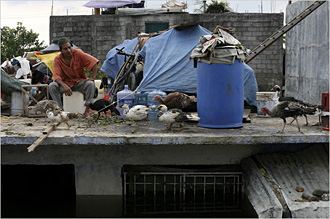 |
 |
 |
 Editorials | Issues | November 2007 Editorials | Issues | November 2007  
Mexican Floods Push Families to Last Islands of Home
 Elisabeth Malkin - NYTimes Elisabeth Malkin - NYTimes
go to original


| | Heriberto de la Cruz sat on his rooftop with the chickens, hens and geese he managed to save from the flood. (Jennifer Szymaszek/The New York Times) |
Villahermosa, Mexico - Javier Hernández and Ángel Pérez killed a pig on Wednesday morning on their rooftop. That is where they are living.

The pig will feed four families, 14 people in all, who have lived for the past eight days on the third floor and the roof of a concrete home overlooking this flooded city. The youngest of the group is a girl, just 11 years old.

There was a sense of urgency on the rooftop, as most of the group set to work carving, curing and cooking the meat. “This is called survival,” said Mr. Hernández as he sliced the pig into slabs and passed them to Mr. Pérez, who poured salt on them. “What else can we do?”

There are thousands of people living like this on the roofs and the top floors of their houses in Villahermosa, much of which is underwater after rain-swollen rivers and lagoons flooded the gulf state of Tabasco last week.

Just as Hurricane Katrina produced pictures that will forever mark Americans’ memories of New Orleans, the flooding here has created its own bank of images. There are dramatic helicopter rescues and crowded shelters. But the strangest stories belong to those people who have chosen to remain camped out on their roofs, often with their families. They are prepared to stay there for as long it takes.

These people are used to fending for themselves in a country where government services often fall short. “The family won’t be able to hang on without eating,” said Mr. Hernández as he washed part of the pig’s carcass in a bucket. “We have to do everything ourselves now.”

There are those who cannot bear the idea of being herded around and following rules in shelters. “They turn off the lights,” Mr. Pérez said. “What a joke.”

Most of those on the roofs said they were there to protect against looters who cart off the television sets and washing machines that were carried up there as the floodwaters rose.

Inocencio Ortiz, 59, sells clothing in markets around the state. It took him five years to save up for his 1987 pickup truck, and now it is gone, along with his entire inventory. “I’ll have to start over,” he said. A grandniece came back from dry land to relieve him on Tuesday, but Mr. Ortiz did not want to go.

Under the tarpaulin he has rigged on his rooftop to protect the mattresses from the sun, he has set up an improvised altar, with a picture of the Virgin of Guadalupe, several candles and a wooden figure of Christ with rosaries. “We always pray to the Virgin,” he said. “We believe that yes, faith will help us.”

There are some who had no choice but to stay. Alicia and Martín Hernández remained to care for her 100-year-old father. Their three teenage children and three other relatives are also there, along with a few chickens and turkeys. They are crowded into three rooms upstairs that Mr. Hernández, a carpenter, had used to paint and varnish furniture.

From the rooftops, there is stillness, freezing the moments last week when the rivers rose and people moved what they could up to their roofs. At times, the water has covered a house, and the mound of furniture piled on top appears to float.

The water has given inanimate objects their own life. The water lifted a refrigerator with so much force that it peeled back the tin roof on one house.

In an unfinished Roman Catholic church, the water level has dropped, leaving a water line across the knees of Christ on the cross. Somebody left a motorcycle next to the figure, perhaps to protect the bike.

A community has taken shape. At night the neighbors signal one another with flashlights, letting potential looters know not to come near. The boredom is excruciating. Those with batteries listen to radios. Those without canoes to go calling on their neighbors fashion their own makeshift rafts out of water jugs, plastic fuel drums and scrap wood.

If they have money, they flag down a passing boat and go downtown to an air-conditioned supermarket on dry land.

Those who have no money improvise, hoping for a handout from a passing boat, and killing their ducks and turkeys. Miguel Ángel Arias sat in a red plastic chair and pulled up a turtle on a line, which he threw into a bucket. “We’re used to eating this,” he said. “We have nothing else.”

But there is at least one person in this city who could not guard his most valuable possessions on his roof. He is trapped on dry land. Parked at the foot of the bridge joining Las Gaviotas with downtown is a pickup truck holding three pigs belonging to Antonio Ortiz, a butcher. When the floodwaters rose his only concern was to rescue his pigs, worth $600. So he piled them in his truck and raced to the bridge.

Since he has nowhere to leave the pigs on the other side, they remain in the back of the parked truck. Mr. Ortiz stays by them. Every day, he cleans out the truck, washing the pigs and dumping the waste into the floodwaters.

And there he will remain, he said, until he can take the pigs home. | 
 | |
 |



